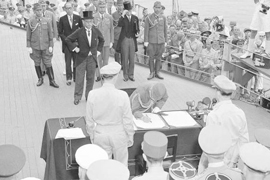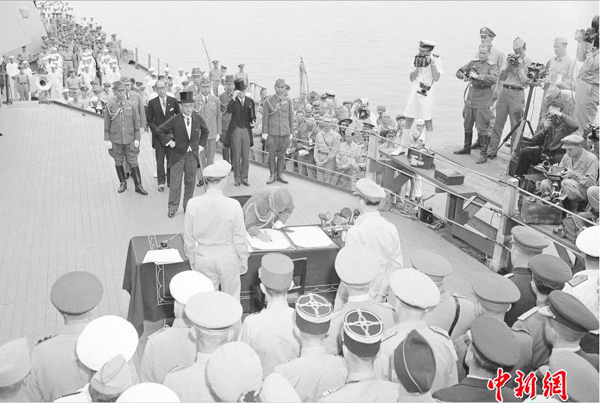Japan's surrender marked victory over Axis powers

 0 Comment(s)
0 Comment(s) Print
Print E-mail CNTV, August 18, 2014
E-mail CNTV, August 18, 2014
September 2nd, 69 years ago, was a day of victory for the Allied forces. Japan signed documents of surrender, marking the end of World War Two and total victory over the Axis powers. Today, as Japanese nationalism is once again on the rise, let's take a look back at the closing days of World War Two and the lessons that were learned.
 |
|
Japan signed documents of surrender, marking the end of World War Two and total victory over the Axis powers. |
Years of war and struggle, all ended on the Battleship Missouri. On September 2nd, 1945, representatives of Japan and the Allies came face to face on the deck of a U.S. naval ship. It was there that Japan signed the instrument of surrender, formally ending the Second World War.
It came 3 months after Germany's surrender in May. At that time, Japan's fuel shipments were being intercepted, and it had lost control of sea and air after several defeats in the Pacific theater. China's counter offensive had also taken its toll on Japan's ground forces, while back on the home islands domestic anti-war voices were getting stronger.
On July 26th, China, America and Britain issued the Potsdam Declaration, an ultimatum to the Japanese to surrender.
Japan refused and on August 6th, the U.S. dropped an atomic bomb on the Japanese city of Hiroshima, and three days later another atomic bomb was dropped on Nagasaki. The blast itself and the radiation it left behind would leave hundreds of thousands dead within the first four months alone.
|
|
|
Japan signed documents of surrender, marking the end of World War Two and total victory over the Axis powers. |
Japan officially surrendered shortly afterward on August 15th. Emperor Hirohito announced over the radio that the country would lay down its arms and accept the terms of the Potsdam Declaration unconditionally.
The day after the surrender ceremony, September 3rd, saw celebrations across the globe. The date is also marked in China to commemorate the victory in the War of Resistance against Japanese Aggression, which started in 1937. In the 8-year war, China lost more than 20 million lives and saw damage worth more than 500 billion US dollars.While Japan's toll of casualties was around 2 million.
During World War II, China was the major battlefield in the fight against Japanese aggression, as well as the major oriental battlefield in the war against fascism worldwide.
The battleship that witnessed the end of fascism is now a memorial open for visitors. The location where the Japanese signed the surrender document is marked—a reminder to all of the cost of war.







Go to Forum >>0 Comment(s)